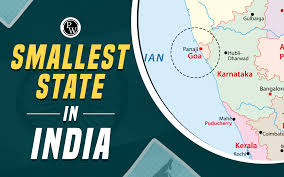Goa, despite its small geographical size, is one of the most unique and culturally rich states in India. Here is a detailed overview of its geographical, historical, cultural, and economic aspects.
- Area: Goa spans 3,702 square kilometers, making it the smallest state in India by land area.
- Percentage of India’s Total Area: It constitutes around 0.11% of India’s total land area, which is about 3.287 million square kilometers.
- Goa is situated along the western coast of India, bordered by the Arabian Sea to the west.
- It shares its borders with Maharashtra to the north and Karnataka to the east and south.
- The state is well-known for its scenic beaches, including Anjuna, Calangute, Baga, and Palolem, as well as its lush green landscapes and rich biodiversity.
- Goa was a Portuguese colony for over 450 years (1510-1961), during which it developed a unique blend of Portuguese and Indian cultures. The influence of Portuguese architecture, religion, and cuisine is evident across the state.
- Goa was liberated and annexed into India on 19 December 1961 after a military operation known as Operation Vijay. This marked the end of over four centuries of Portuguese colonial rule.
- After its annexation, Goa became a Union Territory of India. It was later granted statehood on 30 May 1987, becoming the 25th state of India.
- Goa is known for its gorgeous beaches, which attract millions of tourists annually. The Anjuna Beach, Baga Beach, and Calangute Beach are some of the most famous.
- The state also features lush green forests, waterfalls, and rivers like the Mandovi River that add to its natural charm.
- Goa has a tropical climate, with hot and humid weather for most of the year, and a monsoon season between June and September. The monsoon rains transform the region into a lush, verdant paradise.
- Goa is one of the most popular tourist destinations in India, renowned for its beaches, vibrant nightlife, and Portuguese colonial architecture.
- Visitors come from all over the world to enjoy the sun, sea, and sand along with cultural experiences like Goan music, dance, and cuisine. Eco-tourism and heritage tourism are also prominent in the state.
- Goa’s Portuguese influence is evident in its churches, forts, and festivals. The Basilica of Bom Jesus, Se Cathedral, and Aguada Fort are examples of its rich history.
- The state is known for its distinctive music and dance, such as Fado and Dekhnni, as well as its vibrant celebrations of festivals like Carnival, Christmas, and Shigmo (a spring festival).
- Konkani is the official language of Goa, and English and Marathi are widely spoken, especially in urban areas.
- Tourism is the backbone of Goa’s economy, contributing significantly to employment and the state’s GDP.
- Agriculture, including rice, cashew nuts, and coconuts, also plays a role in the economy, along with fisheries.
- Goa is a producer of iron ore and manganese, although the mining industry has faced regulatory challenges.
- Industry in Goa includes pharmaceuticals, chemicals, and food processing.
- Capital: Panaji (also known as Panjim) serves as Goa’s capital. It is a small yet bustling city located on the banks of the Mandovi River. Known for its colonial architecture and vibrant markets, Panaji is the administrative and cultural center of the state.
- Largest City: Vasco da Gama, located near the Mormugao Port, is Goa’s largest city. It is an important hub for shipping and trade.
Goa, despite being India’s smallest state in terms of area, holds a significant place in the country’s tourism, culture, and economy. Its beautiful beaches, vibrant history, and Portuguese legacy continue to attract people from all over the world. The fusion of diverse cultural influences and the state’s natural beauty make Goa a unique part of India.







